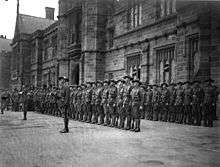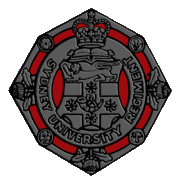Sydney University Regiment
| Sydney University Regiment | |
|---|---|
|
Cap badge of the Sydney University Regiment | |
| Active | 1900 – present |
| Country |
|
| Branch | Army Reserve |
| Type | Officer Training |
| Role | Army Reserve Officer Training |
| Size | Regiment |
| Part of | 5 Brigade |
| Garrison/HQ | Sydney (Darlington) |
| Colours | Blue & Gold and Black & Red |
| Anniversaries | 17 November 1900 |
| Insignia | |
| Unit Colour Patch |
|
Sydney University Regiment (SUR) is an officer-training regiment of the Australian Army Reserve. Its predecessor, the University Volunteer Rifle Corps, was raised in 1900 as a unit of the colonial New South Wales Defence Force. During the 20th century, several changes of name and role occurred. Sydney University Regiment is headquartered in Holsworthy Barracks and has detachments in Sydney, Canberra and Wollongong.
History
Early years
The University Volunteer Rifle Corps (UVRC) was raised on 17 November 1900, as part of the colonial military forces of New South Wales. The University of Sydney was the colony's only university at the time, and two of its professors, T. W. Edgeworth-David and J. T. Wilson. VD, a former officer of the East Surrey Regiment, and employed as a teacher of physics at the university, encouraged the formation of a volunteer military unit.
Military training commenced in early 1901 with one hundred volunteers. The volunteers held their first parade in uniform later that year, when visited by the Duke of York, later to become George V. The UVRC appeared in public for the first time at a review ceremony in Centennial Park on the occasion of the coronation of Edward VII.
In 1903, the UVRC changed its name to the Sydney University Scouts (SUS) and the establishment had by then doubled to two rifle companies. When "universal" boyhood conscription was introduced in 1911, the Scouts' numbers increased, since all eligible undergraduates of the university were drafted into it[1] and it became a militia battalion. At this time it also became responsible for the training of boy soldiers, the forerunner of today's Australian Cadet Corps, during their attendance at camps.
World War I
On the outbreak of the World War I, over sixty percent of the Scouts enlisted in the Australian Imperial Force (AIF). Members of the Scouts served widely within the AIF. In mid-1918 a university company was recruited from students at the University of Sydney for active service in the AIF. The war ended before it mobilised for service.
1920s

A regimental band of pipes and drums was formed in 1925. In 1927 the University Scouts were renamed the Sydney University Regiment (SUR). In recognition of its members' service in the Great War, Lieutenant-General Sir Harry Chauvel presented the regiment with its first King's and regimental colours. A display was presented by the regiment's artillery unit.[1]
In 1929, King George V approved the SUR's affiliation with the 60th Regiment, The King's Royal Rifle Corps (KRRC) and consequently the regiment's embellishments and badges of rank became black with a red felt backing. These distinctive arrangements continue and are unique in the Australian Army. This alliance was maintained with The Royal Green Jackets of the British Army, the successor regiment to the KRRC until its amalgamation.
World War II
The regiment per se was not mobilised; but, as in the World War I, many serving and former members of the SUR enlisted in the Second AIF and served with distinction in all theatres of war. A notable example was Sir Arthur Roden Cutler, who had enlisted in the SUR Transport Platoon in 1936. He enlisted in the Second AIF and was awarded the Victoria Cross on 28 November 1941 "for most conspicuous and sustained gallantry, and for outstanding bravery from 19th June to 16th July in Syria."
1960s
In 1960, the regiment's campus HQ was destroyed by fire. (The regiment was subsequently rehoused at a new facility on university-owned land at Darlington.)[2]
National Service (conscription of 20-year-olds by ballot) was introduced by the Menzies government in November 1964 and operated until December 1972. During this period, the regiment provided an alternative form of military service for university students. SUR during this period consisted of four rifle companies, a recruit-training company and an HQ and support company. The support company provided mortar, signal, pioneer and transport platoons. This was a period of increasing student activism and, in particular, protests against conscription and Australia's participation in the Vietnam War. In May 1969, protesting students confronted a guard of honour for Sir Roden Cutler VC, who was honorary colonel of the regiment and governor of NSW.
1990s
The regiment received new colours in 1994, from the state governor, Rear Admiral Peter Sinclair. In 1997, the regiment came under command of the Royal Military College, Duntroon, tasked with conducting training that prepares part-time officer cadets for their final attendance at the college.[2]
Notable graduates
- Sir Roden Cutler VC
- David Hurley
- Douglas Mawson
- Bill O'Reilly
- Max Willis
- Victor Windeyer
- Sir Errol Knox
- Gough Whitlam AC, QC
- Brigadier Sir Frederick Chilton CBE DSO
- Justice Roderick Howie QC
- Major General Paul Brereton AM, RFD, SC
- Captain Peter Collins AM, RFD, RAN, QC
- John Aquilina
- Alexander Boden
- Errol Solomon Meyers, prominent Brisbane doctor and one of the founding fathers of the University of Queensland School of Medicine
See also
- Officers' Training Corps (UK equivalent)
- Reserve Officers' Training Corps (US equivalent)
Notes
- 1 2 University Regiment : Colours presented : Artillery display Sydney Morning Herald 12 September 1927, at Trove
- 1 2 Sydney University Regiment Presentation of the Queen's and Regimental Colours Historical exposition at Regimental Books website. Accessed 27 May 2012
References
- ASIO brief for Prime Minister, Appendix C to minute on "Demonstrations", 13 May 1969, PMD file 69/1407, CRS A463/36, AA.
- Chapman, Ivan.(1996). Sydney University Regiment: The First 80 Years. Self-published. OCLC 223331199.
- Dart, JR. "Student Protest and the Sydney University Regiment", Australian Infantry 16/1 (1970): 16–17.
- Lilley, Alan Bruce. Sydney University Regiment: a description of the insignia worn from 1900–1973 by military units at the University of Sydney, together with information on honorary colonels and commanding officers. Military Historical Society of Australia, 1974.
- A history of the pipes and drums of the Sydney University Regiment. Sydney University Regiment Historical Society, 1977. ISBN 0-9596352-0-3

